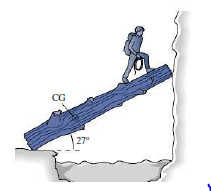
Concept explainers
Climbers attempting to cross a stream place a 340-kg log against a vertical, frictionless ice cliff on the opposite side (Fig. 12.25). The log slopes up at 27° and its center of gravity is one-third of the way along its 6.3-m length. If the coefficient of friction between the left end of the log and the ground is 0.92, what’s the maximum mass for a climber and pack to cross without the log slipping?

FIGURE 12.25 Problem 35
Want to see the full answer?
Check out a sample textbook solution
Chapter 12 Solutions
Essential University Physics Volume 1, Loose Leaf Edition (4th Edition)
Additional Science Textbook Solutions
Brock Biology of Microorganisms (15th Edition)
Biology: Life on Earth (11th Edition)
Cosmic Perspective Fundamentals
Campbell Essential Biology with Physiology (5th Edition)
Human Physiology: An Integrated Approach (8th Edition)
Human Biology: Concepts and Current Issues (8th Edition)
- A uniform 3 m long ladder of mass 20 kg leans against a wall. The coefficient of static friction between the ladder and the floor is 0.25. What is the reaction force by the wall?arrow_forwardThe strength of Earth's gravity at ground level = 9.8 N kg-1. 1 tonne = 1000 kg. Where forces are asked for, ensure that the direction is in the answer (e.g. up/down). Assume that the mass is evenly distributed in the rulers, poles, planks, bridge spans mentioned in the questions. A 200 m bridge span is supported at both ends. The span has a mass of 100 tonnes. A 30 tonne bus is 50 m from one end of the span. Calculate the supporting force holding the bridge up at the end nearer the bus. Please give your answer to 2 significant figures. Value Unitsarrow_forwardA bridge crossing a ravine has mass Mb and length L. The bridge is supported by pilings at points A and B at the right and left ends. A truck of mass mt stops at the point L/3 from point B. Find expressions for Fa and Fb, the forces supporting the bridge at each end.arrow_forward
- The weightless strut in the figure below is not attached to the wall; it is prevented from falling only by friction. (Let w = 395 N, L = 5.15 m and h = 3.10 m.) (a) Find the magnitude of the force of friction between the wall and the strut.(b) Find the normal force exerted by the wall on the strut.(c) Find the minimum coefficient of static friction.arrow_forwardA man is walking over a dome of 10 m radius. How far he can descend from the top of thedome without slipping ? Take coefficient of friction between the surface of the dome andshoes of the man as 0.6. [Ans. 1.413 marrow_forward1111arrow_forward
- A block weighing 80N rests on a horizontal floor. An inclined force P with a slope of 5 vertical to 12 horizontal and up to the right was applied at its center of gravity. The coefficient of kinetic friction between the block and the floor is 0.26. Find the value of force P that will give the block an acceleration of 2.5 m/sec^2.arrow_forwardPlease help mearrow_forwardThe two 3.6° wedges shown are used to adjust the position of the column under a vertical load F of 6.1 kN. Determine the magnitude of the forces P required to raise the column if the coefficient of friction for all surfaces is 0.32. Assume = 3.6° P 0 Answer: P = CON F Ө kNarrow_forward
- A 550 g squirrel with a surface area of 920 cm2 falls from a 5.6-m tree to the ground. Estimate its terminal velocity. (Use the drag coefficient for a horizontal skydiver. Assume that the squirrel can be approximated as a rectanglar prism with cross-sectional area of width 11.5 cm and length 23 cm. Note, the squirrel may not reach terminal velocity by the time it hits the ground. Give the squirrel's terminal velocity, not it's velocity as it hits the ground.) What will be the velocity of a 55.0 kg person hitting the ground, assuming no drag contribution in such a short distance?arrow_forwardPlease atleast answer this questionarrow_forwardA 170-kg unlform steel beam 8.25 m in length rests against a frictionless vertical wall, maldng an angle of 50.0° with the horizontal. A 70.0-kg construction worker begins walking up the beam. The coefficient of static friction between the beam and the ground is 0.750. What are the horizontal and vertical forces exerted on the beam by the ground when the worker has walked 3.00 m along the beam? (Enter the magnitude.) Fhorizontal Fvertical = Need Help?arrow_forward
 College PhysicsPhysicsISBN:9781305952300Author:Raymond A. Serway, Chris VuillePublisher:Cengage Learning
College PhysicsPhysicsISBN:9781305952300Author:Raymond A. Serway, Chris VuillePublisher:Cengage Learning University Physics (14th Edition)PhysicsISBN:9780133969290Author:Hugh D. Young, Roger A. FreedmanPublisher:PEARSON
University Physics (14th Edition)PhysicsISBN:9780133969290Author:Hugh D. Young, Roger A. FreedmanPublisher:PEARSON Introduction To Quantum MechanicsPhysicsISBN:9781107189638Author:Griffiths, David J., Schroeter, Darrell F.Publisher:Cambridge University Press
Introduction To Quantum MechanicsPhysicsISBN:9781107189638Author:Griffiths, David J., Schroeter, Darrell F.Publisher:Cambridge University Press Physics for Scientists and EngineersPhysicsISBN:9781337553278Author:Raymond A. Serway, John W. JewettPublisher:Cengage Learning
Physics for Scientists and EngineersPhysicsISBN:9781337553278Author:Raymond A. Serway, John W. JewettPublisher:Cengage Learning Lecture- Tutorials for Introductory AstronomyPhysicsISBN:9780321820464Author:Edward E. Prather, Tim P. Slater, Jeff P. Adams, Gina BrissendenPublisher:Addison-Wesley
Lecture- Tutorials for Introductory AstronomyPhysicsISBN:9780321820464Author:Edward E. Prather, Tim P. Slater, Jeff P. Adams, Gina BrissendenPublisher:Addison-Wesley College Physics: A Strategic Approach (4th Editio...PhysicsISBN:9780134609034Author:Randall D. Knight (Professor Emeritus), Brian Jones, Stuart FieldPublisher:PEARSON
College Physics: A Strategic Approach (4th Editio...PhysicsISBN:9780134609034Author:Randall D. Knight (Professor Emeritus), Brian Jones, Stuart FieldPublisher:PEARSON





